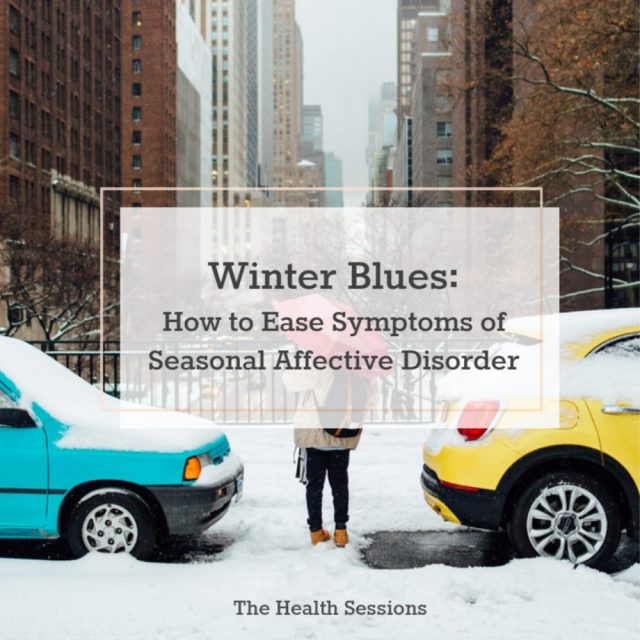The Nuances of Trauma: Why It’s Important to Treat Unhealed Trauma

Do you start to feel down, sluggish and carb-hungry as soon as the days are getting shorter?
This time of year, when it’s cold and dark outside, can trigger the winter blues in many people. It’s no wonder the third Monday of January was dubbed ‘Blue Monday’ by the travel world to promote trips to exotic destinations.
Seasonal changes, especially a lack of daylight, can disrupt your biological clock. Your internal clock regulates countless of bodily functions, including your sleep-wake cycle, alertness and energy levels, and your mood.
In around 5% of people living in northern latitudes, these changes in circadian rhythm contribute to feelings of depression. These recurring depressive episodes in autumn and winter are called seasonal affective disorder (SAD). Just like a ‘regular’ depression, seasonal affective disorder is characterized by a depressed mood, loss of interest in activities, withdrawal from social interactions and problems with sleeping and appetite. Symptoms like oversleeping and craving carbohydrate-rich foods are characteristic for winter seasonal affective disorder.
According to the American Psychological Association, January and February are the most difficult months for people affected by seasonal affective disorder. If escaping to a tropical island isn’t an option, what can you do to beat the winter blues?
Take a look at these 7 ways to ease your seasonal affective disorder and brighten your mood this winter.
Disclaimer: Always seek help from your doctor, psychologist or other medical professionals when you struggle with severe depression and/or have suicidal thoughts!

This blog post contains affiliate links, at no extra cost to you. All opinions are my own.
Although the exact cause of SAD is still unclear, many experts believe that the lack of sunlight in autumn and winter contributes to the onset of seasonal depressive episodes. The reduced sunlight disrupts your biological clock and may cause a drop in mood-regulating serotonin levels.
That’s why light therapy is an effective tool to ease seasonal affective disorder. Exposing yourself to bright artificial light, preferably in the morning, can significantly reduce winter depressive symptoms. And the good news is, you can do light therapy from your own home.
You can set up a light box in a convenient place on your desk or dining table, about two feet away from your eyes. That way you can sit in front of the light box and work, read your morning paper or eat breakfast while doing light therapy. Don’t look directly into the bright light, because it can damage your retina.
Light therapy sessions usually take between 20-30 minutes each day. The exact duration depends on the intensity of your light box, so make sure you follow the manufacturer’s instructions and your doctor’s recommendations. Light therapy can boost your mood and energy levels, but you have to be consistent and stick to a daily routine throughout the season.
When it’s cold and dark outside, it’s tempting to just curl up on the couch and binge-watch Netflix all night. But staying physically active has many proven benefits for your mental health.
Studies indicate that moving your body for 30 to 60 minutes each day can protect against seasonal affective disorder. In some people, exercise can be as effective as antidepressants to treat mild depression.
Moving your body on a regular basis boosts the production of feel-good brain chemicals like serotonin and endorphins. What’s more, exercising promotes restorative sleep – something many people with depression struggle with.
You don’t have to break a sweat each day to get these benefits – going for a walk, cycling to work and living-room dance parties count too. Find an activity you enjoy and get your body moving for 30 minutes every day. Bonus points for exercising outdoors – think: hiking, ice skating, horse riding – or inviting an exercise buddy to support you!

It may sound boring, but your body and brain enjoy sticking to a daily routines. Having meal times will keep your blood sugar levels – and therefore your energy and focus – more stable throughout the day, while a bedtime routine will signal to your body that it’s time to wind down.
A disrupted sleep-wake cycle, like insomnia or oversleeping, plays a big part in the onset, course and persistence of all mood disorders. Research shows that catching light in your eyes in the morning is vital for a healthy circadian rhythm. Not only does it signal the start of a new day, it also gives your brain important cues about the changes in day length throughout the seasons. That’s why you can ease your winter blues by exposing yourself to sunlight early in the morning. Open your curtains when you wake up, go for a morning stroll or reset your body clock with a dawn simulator like Philips Wake-Up Light Alarm.
Besides the biological aspects of a healthy circadian rhythm, there are other mental health benefits of sticking to a daily schedule. Structuring your day with a predictable pattern of meal times, waking and sleeping can lower your stress levels. When you have routines, performing your daily to-dos requires a lot less brainpower – so you’ll feel more equipped to handle the more complex things in life. It also makes it easier to build and stick to healthy habits like exercising and a balanced diet.
Don’t know where to start? Take a look at how you can reset your sleeping patterns with a relaxing bedtime ritual, or try these ideas for a healthy morning routine.
Vitamin D isn’t just important to keep your bones healthy, it also plays a role in brain development and functioning. Your body produces vitamin D when your skin gets exposed to sunlight. But in autumn and winter, countries further away from the equator cannot get enough UV-B light to make vitamin D.
Studies suggest that seasonal affective disorder may be caused by low levels of vitamin D3, which can affect serotonin levels in the brain. So when you’re battling with the winter blues, it’s wise to check your vitamin D levels and get good-quality supplements if needed. You can also keep your vitamin D levels up by consuming cod liver oil, fatty fish, egg yolks and fortified foods like dairy or cereals.

Do you turn to brownies to boost your mood? You’re not alone.
Most of us love to eat carbohydrate-rich foods like cookies and comfy bowls of pasta when it gets cold outside. But carb cravings can also be a symptom of seasonal affective disorder, in an unconscious attempt to produce more serotonin, the feel-good hormone.
Sounds like a great solution right? Unfortunately, eating simple carbohydrates like cakes and croissants cause a spike in your blood sugar levels, which is followed by a sudden drop in energy level. This sugar crash makes you feel tired, irritated, anxious and unable to concentrate. What’s more, one study found that carb cravers may eat an additional 800 calories a day, leading to weight gain.
Therefore, it’s best to keep your blood sugar levels stable by eating balanced meals and snacks throughout the day. Choose wholegrain versions of bread, cereals, pasta and rice to prevent sugar crashes. You can comfort your cravings with slow carbs like porridge, wholegrain waffles, comforting grain bowls, sweet potato fries and wholesome pizzas. What’s more, adding healthy fats and protein to carb-heavy meals can also help stabilize your blood sugar levels and minimize mood swings.
Finally, foods rich in omega-3 fatty acids, such as salmon, sardines, walnuts and chia seeds, also prove to elevate your mood. So make some healthy tweaks to your diet to fight those winter blues.
As the name suggest, complementary therapies like aromatherapy, herbal medicine and acupuncture, may not replace medication or psychotherapy, but they can help ease symptoms of depression.
The herbal remedy St. John’s wort, for example, has been used for centuries as a treatments for mood disorders. A systematic review study indicates that St. John’s wort can be as effective as antidepressants in treating mild depressive symptoms. However, St. John’s wort can interact with numerous medications, so please consult your physician or pharmacy before combining this herb with prescribed drugs.
Acupuncture may also be an effective and painless treatment to reduce depressive symptoms. Mind-body interventions that promote relaxation, decrease stress and release serotonin and dopamine – such as yoga, massage and meditation – can improve your mood too.
Essential oils are another drug-free option to help you manage seasonal affective disorder. Small studies suggest that using lavender oil, wild ginger oil and bergamot oil have calming effects, which reduce feelings of depression and anxiety.

When the days get dark and short, it’s tempting to curl up on the couch, binge-watch Netflix and stay cooped up inside all winter. I mean, hygge keeps the Danes happy during the cold winter months, right?
But as cozy as cocooning can be, make sure you stay active and keep socializing. Social withdrawal only complicates seasonal affective disorder, so make a conscious effort to meet up with friends and family. Keep yourself busy with activities you usually enjoy or try a new wintertime hobby like ice-skating, knitting a scarf or going for a hike (with a healthy hot chocolate afterwards of course!).
For more information on how to ease symptoms of seasonal affective disorder, read ‘Winter Blues: Everything You Need to Know to Beat Seasonal Affective Disorder’ by Norman E. Rosenthal.
And again, don’t hesitate to consult your doctor or psychologist if you need medical assistance to deal with seasonal affective disorder.
If you enjoyed reading this article, you might also like: